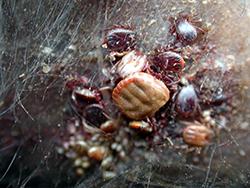- Home
- About
- Educational Resources
- Audiovisual/Teaching materials
- Livestock health, management and production
- Wildlife health, management and production
- Companion animal health
- Health management tools
- Drivers of emerging and re-emerging diseases
- Arthropod vectors
- Zoonoses
- Ecosystems and ecology
- Veterinary public health and food safety
- International trade and marketing of animal commodities and products
- Animal welfare
- Policy, planning and legislation
- CPD
- Academic programmes
- Research
- News and Events
- Links
- Contact
Tick identification

The ear of an animal parasitised by the brown ear tick, Rhipicephalus appendiculatus, the vector of the protozoan causing East Coast fever (ECF).
|
Term: 2013
|
Published: November 18, 2013 |
| Revised: July 30, 2015 |
Keywords:
Fact sheet
Fact sheet: Tick identification
Systematics/Taxonomy
There are three families of ticks although one family, Nuttallielidae comprises only one species. Hard ticks or Ixodidae are characterized by the presence of a hard scutum or shield and mouthparts projecting forward which makes them visible from the dorsal side. In soft ticks or Argasidae, the mouthparts are recessed ventrally except in the larval stage.
Seasonal occurrence and life cycles
Most ticks show seasonality in their life cycles; adult ticks will become active and feed at the start of the rainy season. The study of the seasonal occurrence of ticks is of major importance in the control of ticks and tick-borne diseases.
Identification and differential diagnosis
The identification of ticks is mainly based on morphological features although the hosts on which they occur, the locality where they were found and their seasonal activity is taken into consideration.
The various genera of hard ticks can easily be differentiated by a set of features unique to each genus: mouthparts, basis capituli, scutum, eyes, festoons, adanal, subanal and accessory anal plates, coxae and anal groove.
The identification of ticks up to species level is much more complicated and requires more expertise.
Find out more
- Tick Importance and transmission: The ticks of veterinary importance and the different routes of transmission, including transovarial, transtadial and intrastadial transmission are described.
- Tick surveillance: Information is provided on the different collection methods of ticks, including vegetation sampling, nest/burrow sampling, tick traps and host sampling methods.
- Control of ticks: Different control strategies (chemical, biological and vaccines), principles of acaricide resistance, and the effect of tick control on endemic stability of tick-borne diseases are described, and information is provided on the different chemical products available.



